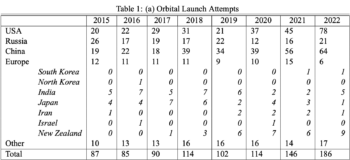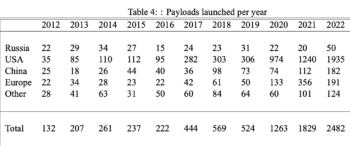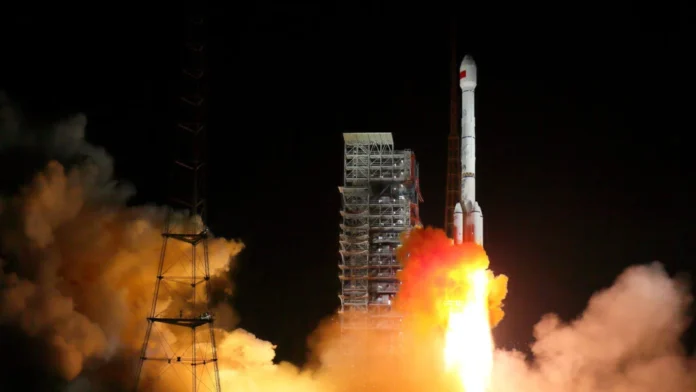“China is replacing Russia as the No. 2 space power,” Jonathan McDowell, an astrophysicist at the Harvard and Smithsonian Center for Astrophysics in Cambridge, Mass., told Breaking Defense.
WASHINGTON — While the US led the world in the total number of space launches in 2022 with China coming in second, a new report calls China the winner for the most defense-related payloads.
“China is replacing Russia as the No. 2 space power,” Jonathan McDowell, an astrophysicist at the Harvard and Smithsonian Center for Astrophysics in Cambridge, Mass., and author of the “Space Activities in 2022” report [PDF], told Breaking Defense Thursday. McDowell is also the author of the online newsletter “Jonathan’s Space Report,” which chronicles worldwide space launches.
The US attempted 78 launches in 2022, with 72 of them successful, according to the report published Tuesday. Russia successfully launched 21. China attempted to launch 64, and 62 made orbit. For each country, many of those launches carried multiple satellites. For specifically defense-related satellites, the report finds that China orbited 45, the US 30 and Russia 15.
The caveat is that it is hard to be certain about the number of Chinese military satellites, the report stresses, because of Beijing’s veil of secrecy surrounding its national security space efforts. For example, the report notes that eight Shiyan satellites were successfully launched to low Earth orbit in 2022 with unknown missions. “The Shiyan (‘Test’) satellites are a cover name for various Chinese government satellites,” the report explains.
While the statistic regarding China’s defense-related payloads is likely to raise blood pressures across the US national security community, an equally important finding of the annual report is that the number of launches and satellites going into orbit in general continues to skyrocket at an ever increasing rate — primarily do to a surge in commercial activities.
“Generally, space traffic is shooting up (pun intended),” McDowell said.
 The number of global space launches leapt in 2022 to 186, with 182 successful. “Of the 186 orbital launch attempts: 82 were carried out by governments; 21 by commercial companies under contract to their host governments, and 83 by commercial companies for commercial customers, including foreign governments,” the report shows.
The number of global space launches leapt in 2022 to 186, with 182 successful. “Of the 186 orbital launch attempts: 82 were carried out by governments; 21 by commercial companies under contract to their host governments, and 83 by commercial companies for commercial customers, including foreign governments,” the report shows.
The number of launches in 2022 was up 40 from 2021, when there were 146 attempts. The annual increase continues a trend that began in earnest in 2015, the report shows.
Those successful launches carried a whopping 2,482 payloads, an artifact of the growing trend — led by US firm SpaceX and its ginormous Starlink constellation of internet satellites — of multiple launches to low Earth orbit on a single rocket.
More surprisingly, said McDowell, is that the number of commercial satellites launched by China is “rapidly increasing.” Of 182 total satellites launched by Beijing, 100 (55 percent) were commercial class, the report shows.
“This is maybe the biggest news that isn’t being much talked about,” he added.

China also became the first country to successfully move a dead satellite out of the way of active satellites in January 2022, the report said, when it used its Shi Jian 21 (SJ-21) spacecraft to capture a failed BeiDou 2-G2 navigation satellite from geosynchronous orbit (GEO) and drag it to a higher “graveyard orbit.”
“This is the first case of actual active debris removal from GEO. It was expected that SJ-21 might repeat the exercise with another satellite, but this has not yet happened. SJ-21 was kept in an orbit that crosses the GEO belt with a slow (0.4 [degree per day]) eastward drift until it reached 165E on Nov 2, when the direction of drift was reversed, probably to keep it within range of Chinese tracking stations,” the report elaborated.
Northrop Grumman’s Space Logistics performed a similar operation in 2020, docking with and moving an Intelsat’s IS-901 from the graveyard into GEO with its Mission Extension Vehicle-1, designed to serve as a new power source and extend the satellite’s life. However, the difference with the SJ-21 mission is that the Intelsat bird was still alive and able to “cooperate” in the maneuver, whereas the BeiDou was defunct, Jim Shell, a space surveillance expert at Novarum Tech, explained on Thursday.
That fact, he added, “hasn’t received adequate attention.”
photo:China launched two BeiDou-3 satellites into space via a single carrier rocket to support its global navigation and positioning network at 7:45 p.m. Sunday Nov. 5, 2019. (Xinhua/Yang Zhiyuan via Getty Images)
https://breakingdefense.com




